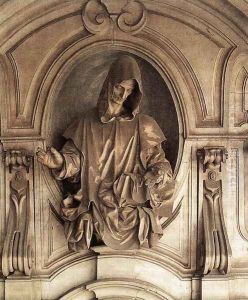Cosimo Fanzago Paintings
Cosimo Fanzago was an Italian architect and sculptor, widely considered one of the most important figures in the development of Baroque architecture in Naples. Born in 1591 in Clusone, in the province of Bergamo, Lombardy, he moved to Naples in 1608. His work in Naples was so influential that he is often referred to as the architect of the Neapolitan Baroque. Fanzago's designs are characterized by their dynamic forms, rich ornamentation, and the interplay of architecture and sculpture.
Fanzago's early works were influenced by his father, who was also a sculptor, and by the local Lombard tradition. However, upon his move to Naples, he came into contact with the burgeoning Baroque style, which was sweeping through Italy following the innovations of architects like Gian Lorenzo Bernini and Francesco Borromini.
In Naples, Fanzago received numerous commissions from religious orders and the nobility, which allowed him to leave an indelible mark on the city's architectural landscape. Some of his most notable works include the church of Santa Maria della Sapienza, the Cappella Sansevero, and the reconstruction of the Certosa di San Martino, a large monastery complex where he worked for over 50 years. He was also responsible for the design of numerous altars, chapels, and sculptures within these and other structures.
Fanzago was not just an architect and sculptor, but also an urban planner; he contributed to the design and layout of several streets and piazzas in Naples. His work was characterized by its dramatic spatial sequences and the integration of sculpture and decorative elements into the architectural fabric.
Despite his significant contributions to the architecture of Naples, Fanzago’s life was not without controversy. His later years were marked by conflict with his patrons and other architects, which led to periods of inactivity. He died in 1678, leaving behind a legacy that would influence Neapolitan architecture for generations. His work remains a testament to the Baroque spirit that defined Italian art and architecture in the 17th century.
